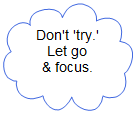
NEUROFEEDBACK BRAIN-BEHAVIOR ASSESSMENT
1. What is bothering you? 2. What features stand out in your SURFACE EEG BRAIN MAPS? 3. When confronted with a vigilance task, how does your brain react?
The EEG is an electroencephalogram, a device used to collect information about the state of brain function.
A lot has changed in the world of neuroscience over the last 20 years. One major advance occurred with the EEG. This involves the discovery of brain 'networks' in the 1990s.
The 'Decade of the Brain' in the 1990s mobilized scientists across the world. Neuroscientists finally broke the code linking surface EEG waves clusters of brainwave patterns.
Today we use these brainwave patterns to help retrain more functional patterns with neurofeedback.
Neurofeedback-assisted Attention/Concentration Training
for ADD, ADHD or Sustained Attention Difficulties
This procedure shapes increased awareness of brainwave activity and cognitive retraining skills [sometimes presented as 'video games'] to voluntarily produce progressively longer sustained attention spans. A common starting point is an excess of attention-draining low-frequency brainwaves.
Clients learn though shaping and trial-and-error learning to attenutate these waves.
With frequent over-training and lots of practice, they will become more confident in recreating these brainwave patterns without feedback tones.
This is a skill, and takes many sessions and a skilled trainer to lock it in.

- What brainwave clusters tend to dominate these Brain Maps?
- It varies with the presenting problem. Sometimes insomnia patterns are prominant.
In a typical clinic session, we look for your brainwave clusters using Brain Maps.
We may take a close look at Continuous Performance Tasks and Targeted Symptom Checklists.
Together these provide information about your particular issue and guide further interest in regions of interest.
This takes about 40 minutes.
- Do Habits Tend Trigger Different Clusters of Brainwave States?
- Yes. When the Brain Maps suggest that networks are out of synch, neurofeedback training exercises are used to strengthen more functional brainwaves clusters.
These new clusters tend to inhibit dysfunctional brainwave clusters.
Neurofeedback guides you to figure out how to modify brainwaves that help keep you calm or focused.
- Or relaxed and ready for sleep.
- Or brighten depression and memory.
- Or cope differently with pain, physical trauma or balance issues.












Why is this important?
Brainwave training relies on different aspects of continuous performance. We will use CPT data in neurofeedback to avoid two errors::
- Commission errors: when a non-target was presented but the user responded anyway. This type of error is related to hyperactivity/impulsiveness.
- Omission errors: is when a target was presented but the user did not respond. This type of error is related to inattention.
These data make neurofeedback more fulfilling.
NEUROFEEDBACK TRAINING
Remember. You are learning a new skill. Practice makes perfect!
We start with some hints:
- Don't try. It puts pressure on you to perform. If necessary, use Thought Interruption first.*
- Your concentration will vary. Just bring your focus back to the task.
- Start simple. EEG Relaxation Training is an excellent place to try out how it works.
- Let your trainer know if you are fatigued or wired. Adjust as needed.
- Training is like any other sport. Pee, drink water and eat something first.
- Try not to miss more then a week without training.
- Daily training is best, if you get a home unit.**
Why is this important?
Many symptoms have been found to be linked to dysfunctional patterns of brainwaves in a particular region of the brain, called Regions of Interest. Your Symptoms may help illuminate regions of interest on your Brain Map.
Brain Map
(hypothetical)
* Though Interruption is described on the page Stop, Look and Listen.
** We only use Muse devics + flex-electrodes for Home Units. A deposit is required.
There are many protocols. ADHD is featured here.
There are 7 subtypes of ADHD based on Dr. Amen's Brain Maps.
We will describe one.
Here is a common example of a training program for one type of ADHD:
Your Neurofeedback tasks are based on your assessment data.

















